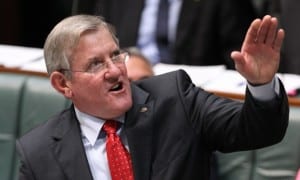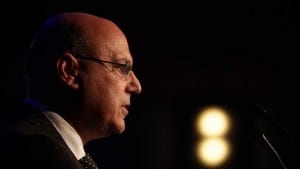 |
| Federal Industry Minister - Ian Macfarlane |
Perhaps the only good news for the Australian renewables industry is that we are now past the half way point of the current federal electoral cycle. The promise of a new government in late 2016, early 2017, may be its only hope of salvation.
Whether that prospect is enough to keep the big international players interested in the Australian renewable energy market is yet to be seen. But right now, it is the only glimmer of hope on the horizon.
The ferocity of the Abbott government’s response to compromise proposals put by the Clean Energy Council, then by major industry groups, and on Thursday by Labor, has caught many by surprise. Industry minister Ian Macfarlane hasn’t just rejected the offer of a compromise cut to the target from 41,000GWh to 33,500GWh, he’s also making stuff up.
Last August, the government’s own Warburton review - despite its ideological position against renewables - rejected arguments put forward by fossil fuel generators that the 41,000GWh target for 2020 could not be built. All it needed was a bit of policy certainty.
Little more than six months later, Macfarlane is now arguing that even a one-third reduction in the new build target - a 33,500GWh target would require 17,500GWh of new build generation rather than 26,000GWh - would be impossible to meet.
In an interview with The Australian, Macfarlane accused the CEC of trying to set up a scheme for failure. He didn’t provide any analysis on why these numbers have changed.
He continued in the same vein on ABC Radio on Thursday. Indeed, environment minister Greg Hunt was using the same argument before Easter, even claiming that the Climate Change Authority had agreed with his assessment, which we pointed out was simply not true.
It summarises the principal frustration of this debate. After the Abbott government was elected, it was about whether the 41,000GWh should stay in place. The numbers have changed, but the arguments have not.
Labor is now holding out the prospect of a higher target if it wins the next poll. It is not talking details, but there are several thing on the cards: lifting the short term target, extending the scheme beyond 2030, and ensuring there is some mechanism to encourage large-scale solar.
But it hasn’t yet explained how, exactly, that may happen. It may be that Labor will have to rethink the entire renewable energy mechanism, given that it has been trashed by the lobbying of the fossil fuel industry and the ideology of the current government.
That ideology was more or less confirmed by the Coalition’s Arthur Sinodinos, who said in a Sky News interview that Labor should give Macfarlane credit for getting the Coalition even to 32,000GWh. The resistance to that had been significant.

Federal assistant treasurer Arthur Sinodinos
“It’s not so much about the science,” Sinodinos said, bowing to the wishes of the Coalition, many of whom don’t accept the science of climate change. And the recent emissions reduction targets discussion paper and the energy white paper gave no acknowledgement to the global 2°C target, instead focusing on scenarios that would usher in warming levels of 4°C.
Labor’s Mark Butler said on Thursday that the Coalition was isolated on the issue. “Labor cannot stand by and watch another industry disappear under the Abbott government’s watch.”
“We are only in this position because Abbott walked away from a crystal clear election promise. Australia was one of the four most attractive countries for renewable energy investment,” he said. Now it risked losing even current projects and jobs.
“We want to talk about an ambitious future for renewable energy,” Butler said.
In the meantime, the question that is hanging over the industry is what would happen if there is no agreement, and the 41,000GWh target remains in place? Clean Energy Council CEO Kane Thornton says no one really knows, but it is likely to be chaos.
That’s because, despite the legislation being in place, few corporates would be willing to allocate hundreds of millions of dollars to new projects. That has been the reason for the standstill in investment in the past 18 months.
Even if the Coalition government does not have the numbers to push through its changes, the fine balance of the Senate means that the numbers could change at any time. International players will not be putting large licks of capital at risk based on the viability of Australia’s Senate cross-benchers.
The big unknowns will be to what extent the retailers decide to build new plant to meet their targets, or try to pass on a “penalty price” to an increasingly dissatisfied consumer base. And there will be a focus on the extent that state governments and corporate consumers could also step into the market.
As Thornton says, the result could be messy. That situation could last until the next election, when Labor - should it win - can either re-establish the 41,000GWh target, possibly with an extended deadline, or map out a higher, longer-term target.
One scenario put forward by a senior renewable energy representative went something like this:
“The most likely outcome is that this issue will continue to fester until the next election. If Abbott is re-elected and has a working majority, the large-scale renewables can book their flights out of the country".
“If Labor gets elected, does what it actually says it will do and follows the advice of the Climate Change Authority, then the industry could be resuscitated. Maybe then they can give some thought about a policy that actually looks beyond the early 2020s, and looks to deal with what happens as more and more Australian coal-fired generators get past their used by date".
“A simple answer is to impose emissions standards, and not extend their lifetime. That will see a relatively orderly transfer that could see most of Australia’s electricity demand satisfied by renewables by 2040 - a contribution of larger wind farm and solar arrays, and maybe even wave energy and geothermal, and as much as half by localised generation - balanced by the storage that networks will find economical to install in lieu of endless upgrades to the poles and wire networks".
“Simple really, as long as you don’t owe your livelihood to a coal-fired generator.”
No comments:
Post a Comment